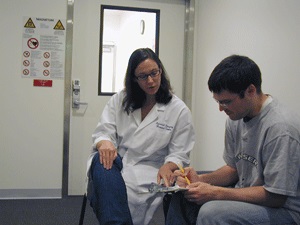AIRC Subject Safety
Subject Definition

A research subject is a human participant who is placed into the bore of the MR Instrument for research purposes.
Subject Safety Hazards
The following is an abbreviated list of potential safety hazards experienced by Subjects.
Static Magnetic Fields
- Always On: This strong magnetic field is always present even in the event of a power outage.
- Proximity: The risk of the strong magnetic field increases the closer an object is to the bore or opening of the MR Instrument.
- Ferromagnetic Objects: Objects that are ferromagnetic may become projectiles with the potential to cause serious, life-threatening injury. Low-weight objects such as belt buckles and steel-tipped shoes may be strongly attracted to an MR Instrument.
Radio Frequency Electromagnetic Fields
- Protection: Subjects must be protected from potential heating and burns.
-
SAR: The FDA sets limits to the amount of heating or the Specific Absorption Rate (SAR) that is allowed.
Time Varying Magnetic Fields: Gradients
- Acoustic Noise: Gradients produce excessive acoustic noise levels for which hearing protection must be provided and worn.
- Nerve Stimulation: Rapidly changing gradient fields used in MR have the potential to cause peripheral nerve stimulation.
-
- Clasped Hands: Research subjects must be instructed to not clasp their hands or in any other way form a closed loop with their extremities to reduce or avoid peripheral nerve stimulation (PNS).
- VNS Implants: Individuals who have Vagal Nerve Stimulation (VNS) implants are NOT safe to participate in a functional MRI (fMRI) study due to the rapid gradient switching required for Echo Planar Imaging (EPI) utilized in fMRI.
Subject Safety Training
No safety training is required for these individuals to enter the magnetic field.
Subject Screening
ALL individuals to be scanned in an AIRC MR Instrument MUST complete a Subject Screening Form prior to entering the MR Scan Room (Scanning Suite). THERE ARE NO EXCEPTIONS TO THIS POLICY.
Not all criteria listed on the Subject Screening Form are grounds for exclusion from ALL MR studies at the AIRC. Exclusion from an AIRC MR study may depend on the nature of the study and the specifics of the contraindication. As a research facility, AIRC faculty or affiliated investigators may study conditions that have an unknown MR contraindication. The criteria below serve as a guide for Principal Investigators for subject study exclusion. For guidance on how to handle specific MR contraindications or exceptions, contact William Woodward
Conditions that are Unknown or Definitely Rule Out a Subject
- Cardiac pacemaker
- Surgical aneurysm clips
- Neurostimulator
- Implanted pumps
- Metal fragments in body / eyes
- Pregnancy
- Nitroglycerin patch (rule out if subject cannot remove patch; foil may heat up)
- Colored contact lenses should not be worn in scanner
- Certain cochlear implants
- Weight >350 lbs. (also consider shoulder and chest size)
Conditions that Might Rule Out a Subject
- Ear implants (most are OK, certain cochlear implants are not)
- Metal rods, plates or screws in body or mouth
- Injury to eyes involving metal (subject must have X-ray exam to rule out fragments)
- Previous surgery (if metal left in body)
- IUD (most are OK, except Copper-7)
- Hearing aid (should be removed before scanning)
- Dentures (should be removed before scanning)
- History of vestibular or inner ear abnormality such as Meniere's Disease
- Prosthetic heart valve (most are plastic now)
- Breast feeding (rule out if using Gadolinium)
- Braces (causes severe frontal artifact; rule out for EPI)
- Hair extensions (most are connected with wire, causes severe artifact)
- Tattoos or permanent eyeliner (if ink contains metallic specks)
- Nicotine patches (those with foil backing)
The AIRC is happy to serve as a resource for MRI safety information. Assuming that there is not an outright manufacture's contraindication for a given implant, it is important to note that the final decision on scanning a subject with a known implant rests with the Principal Investigator.
Due diligence on the part of a Principal Investigator should be done in addition to seeking information from William Woodward or Duane Hickman. All implant manufactures have contact information and most have toll free numbers where they can be reached. It is good practice for Principal Investigators to contact implant manufactures to obtain information concerning their products.
Other Screening Considerations
- Claustrophobia (the Mock Scanner can be used to test sensitivity to enclosed spaces)
- Physical discomfort (body size, back or neck pain, etc.)
- Movement disorders (i.e. ticks, restless legs, etc., that may cause movement artifact)
- Vision / Hearing problems
- Problems using response devices
Things Not to Bring or Wear in the MR Scanning Suite
- ANYTHING in your pockets
- Metal jewelry (face and body piercing items should be removed if possible)
- Watches
- Hair holders
- Eye glasses
- Metal on clothing (i.e. metal buttons, snaps or trimming, underwire bras, belt buckles)
- Eye shadow (many contain metallic specks that can heat up)
- Colored contact lenses (remind subject to bring a case to store contacts in during
Ask before Scanning
If you are unsure whether a subject or object is MR-compatible, do not scan. Contact William Woodward or another AIRC staff member.
How To Be A Research Subject
For more information on how to participate as a subject at the AIRC, see How to be a Research Subject
Contact
For answers to Subject Safety questions, contact William Woodward